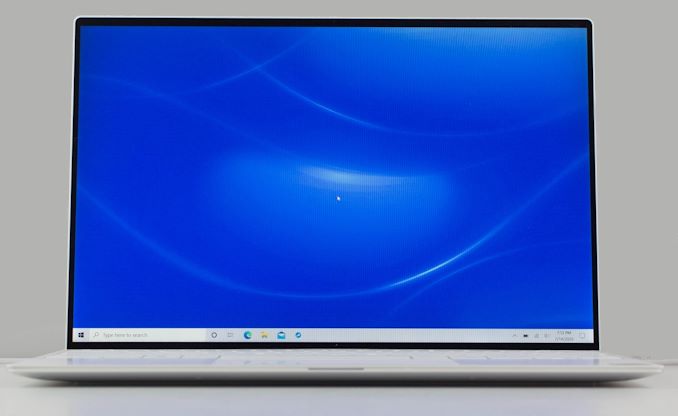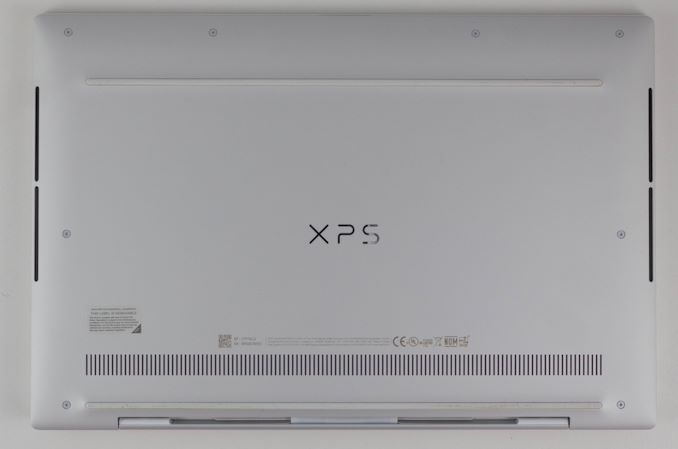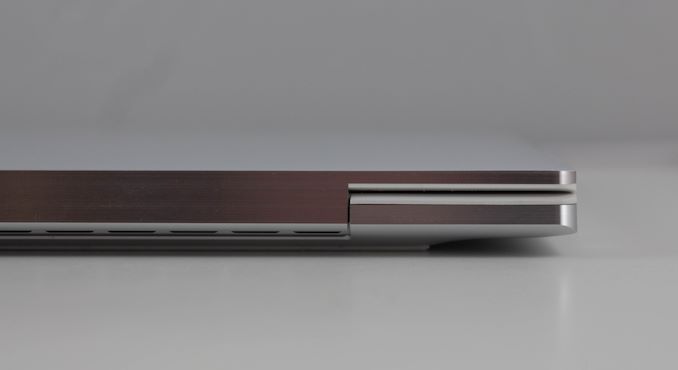The Dell XPS 13 (9300) Review: Return of the King
by Brett Howse on July 16, 2020 10:00 AM ESTFinal Words
Dell’s XPS lineup is one of the strongest in the PC industry. The InfinityEdge display was a revolution, allowing laptop sizes to shrink considerably, while providing the same display size. The new XPS 13 improves on an already excellent pedigree by moving to a 16:10 aspect ratio on the display which further reduces the bezel and keeps the new XPS 13 looking as fresh as ever.
The two color choices are both great, but the Arctic White, with its woven fiber keyboard deck, is really striking. Dell has tweaked this slightly from their original 2-in-1 design by moving back to black display borders, which can help hide the admittedly small bezels even further. The older soft-touch carbon fiber black color is still a great look as well. The refreshed XPS 13 is simply one of the nicest looking notebooks in its class.
The move to Ice Lake in the 2020 refresh is also a welcome addition, mostly thanks to the significantly improved integrated GPU performance, but also because it allows the laptop to support 32 GB of RAM. Coupled with the maximum 2 TB of SSD storage, and the XPS 13 offers plenty of performance for its size. There will be those that lament the lack of an AMD option, as AMD’s latest Renoir is a very potent platform, but the lead time on a notebook like this would preclude that option.
Dell’s decision to move to a 16:10 aspect ratio means that you get a bit more vertical space, which should be beneficial in most productivity scenarios. Of the two display options, unless the wider P3 gamut support of the 3840x2400 display is something critical for a specific workflow, the extended battery life of the 1920x1200 is likely the better option for most people. And, just so it is not forgotten, Dell’s anti-glare coatings are a shot in the arm for the PC industry, providing just 0.65% reflectivity, and when coupled with the very bright display, makes for a winner in almost any lighting condition.
Even the bottom of the XPS is well thought out. Torx screws surround the bottom which allow access inside if needed, and Dell continues to utilize rubber feet which span almost the entire width of the notebook, providing an incredibly solid footprint across a range of surfaces.
Open or closed, the XPS 13 is a fantastic looking device. It backs that up with excellent performance, and plenty of options to fit almost any budget. It is somewhat rare for a premium notebook to start at under $1000 USD, but Dell manages that, if only barely, but the base model now provides 8 GB of RAM and 256 GB of storage, which is much better than some of the XPS 13’s of old, which started with half that RAM and storage for the same price. Dells options are also very reasonable priced, so upgrading from the base model does not instantly launch the price into the stratosphere.
It is great to see Dell update their XPS 13 clamshell notebook to the same internals and design of their previously released 2-in-1 version. It is also great that you can opt for either the clamshell XPS 13, or the convertible 2-in-1, depending on your needs. The convertible offers some increased functionality that you cannot get in a traditional notebook, but there is also a large market that prefers the simplicity of the traditional design. With the XPS lineup, it is your choice.
Finally, in a very rare move, Dell offers not only Windows, but also Linux, giving buyers their choice on what operating system they get. It goes without saying that this is an incredibly uncommon thing on a premium notebook, and very welcome to see. In the case a buyer does opt for Linux, then the the XPS 13 Developer Edition, as it's called, comes from the factory with Ubuntu 18.04LTS.
Overall there is a lot to like about the new XPS 13, and very little to detract from. Dell has yet another winner. With an updated 16:10 display, class-leading battery life, and a fantastic design, the XPS 13 is easily one of the best notebooks around.














224 Comments
View All Comments
Jorgp2 - Thursday, July 16, 2020 - link
>Zen 2 mobile chips easily outperform Ice Lake and Comet LakeOnly in multicore, and only because they have 8 cores.
The Zen 2 architecture still has around Skylake level performance, SNC and WLC have a much higher lead over Skylake than Zen 2 does.
rhysiam - Thursday, July 16, 2020 - link
On what basis are you announcing Sunny Cove and the unreleased Willow Cove as superior architectures? Can you link to some data to support that? Because this review directly contradicts that claim.The lightly threaded tests in this very review show the 4700U trading blows with the 1065G7. Both are clocked similarly. IPC is close in workloads that are relevant to ultrabooks.
I just can't see any basis for the claims you are making here.
Deicidium369 - Friday, July 17, 2020 - link
Comparing a 2020 CPU with a 2019 CPU is not a fair comparison.sorten - Thursday, July 16, 2020 - link
Most of what I do as a software engineer, from the compilers, build tools, and the software I write, eats up the cores. So if I can get 2x the cores for less money, then that's a bonus rather than a point against AMD.vladx - Friday, July 17, 2020 - link
As a fellow software engineer, I still prefer Intel over AMD. What you win with having more cores, you lose with poor compiler optimizations and the big advantage of AVX-512 in certain workloads. Not to mention AMD platforms tend to have more bugs at launch so you spend more time finding workarounds.Spunjji - Friday, July 17, 2020 - link
@vladx with the FUD here. Nice weasel words with "tend to have more bugs" even though we're talking about a specific platform that doesn't have any egregious bugs.Santoval - Friday, July 17, 2020 - link
"and the big advantage of AVX-512 in certain workloads. "Can you name some of these workloads? Even better, out of 10 workloads (or, to make it temporal, out of every "10 programming hours") on average how many can benefit by or be accelerated with AVX-512? Hand on heart answers only please.
As for the "poor compiler optimizations" do you mean the "super aggressive compiler flags Intel tends to prefer that often result in poorer, bug prone code"?
Spunjji below covered me with the arbitrary "bugs" of the "AMD platforms".
Santoval - Friday, July 17, 2020 - link
"The Zen 2 architecture still has around Skylake level performance, SNC and WLC have a much higher lead over Skylake than Zen 2 does."That is pure, groundless BS. You have also confused the Zen 2 "architecture" (thus only the *IPC* of Zen 2) with Skylake's "performance" (both its IPC and clock speed). That is like comparing the acceleration from 0 to 60/100 of one car with the final speed of another car without even realizing the arbitrary comparison.
Finally CPUs with Willow Cove (i.e. Tiger Lake) has not even been released yet, so referring to Willow Cove in the present tense is beyond surreal.
dudedud - Friday, July 17, 2020 - link
Did you even see the Cinebench single threaded results? Zen 2 has Ice Lake performance at around the same clock (4.1 vs 3.9)Brett Howse - Friday, July 17, 2020 - link
There seems to be a lot of misinformation flying around here. Perhaps I should link to our initial Ryzen 7 4700U review in every review I do. Ice Lake is well ahead in single-threaded performance over Zen 2, despite the lower frequency. AMD has double the cores though so even lightly threaded workloads can see a nice improvement.Please reference this:
https://www.anandtech.com/show/15762/the-acer-swif...
Cinebench is just a single workload and is compute bound.
Hopefully we can update our SPEC results with a LPDDR4 laptop as well since our first take was just DDR4.